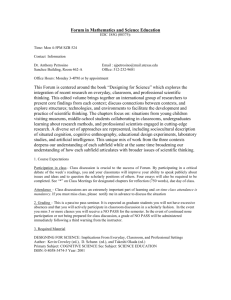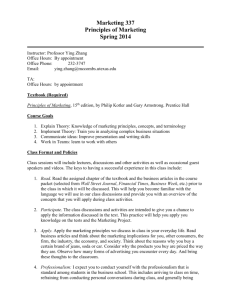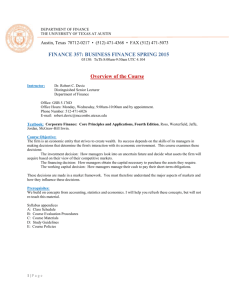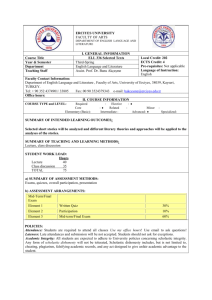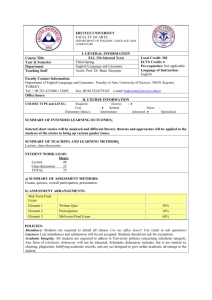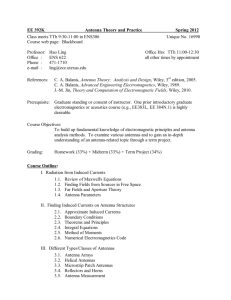fin 371m money and capital markets
advertisement
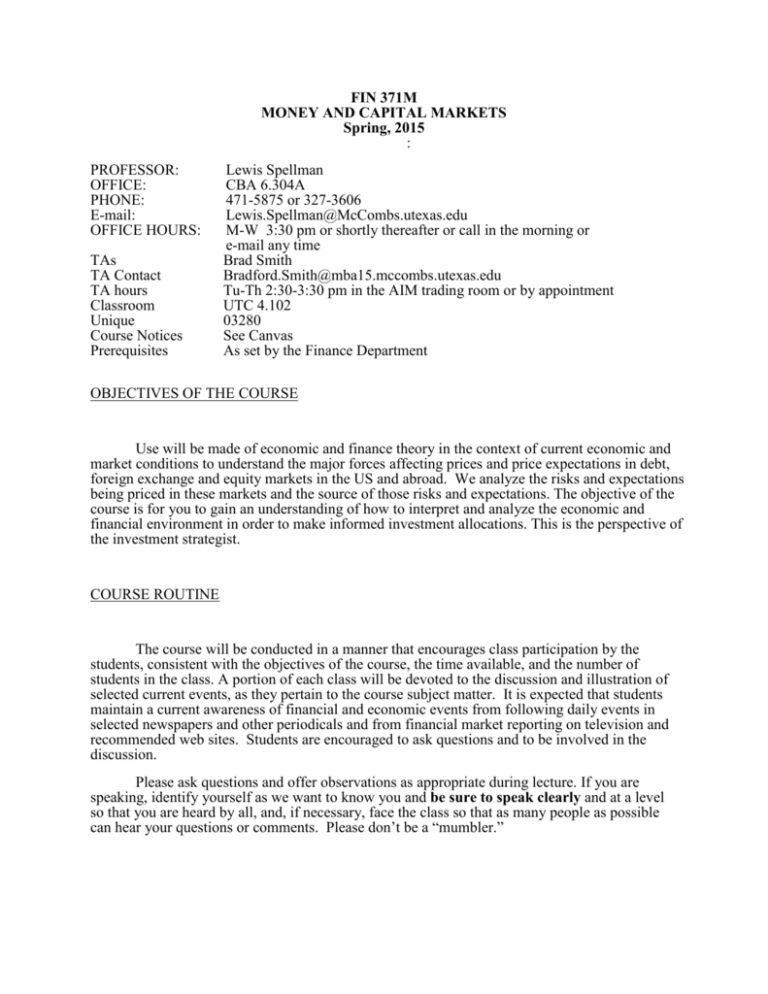
FIN 371M MONEY AND CAPITAL MARKETS Spring, 2015 : PROFESSOR: OFFICE: PHONE: E-mail: OFFICE HOURS: TAs TA Contact TA hours Classroom Unique Course Notices Prerequisites Lewis Spellman CBA 6.304A 471-5875 or 327-3606 Lewis.Spellman@McCombs.utexas.edu M-W 3:30 pm or shortly thereafter or call in the morning or e-mail any time Brad Smith Bradford.Smith@mba15.mccombs.utexas.edu Tu-Th 2:30-3:30 pm in the AIM trading room or by appointment UTC 4.102 03280 See Canvas As set by the Finance Department OBJECTIVES OF THE COURSE Use will be made of economic and finance theory in the context of current economic and market conditions to understand the major forces affecting prices and price expectations in debt, foreign exchange and equity markets in the US and abroad. We analyze the risks and expectations being priced in these markets and the source of those risks and expectations. The objective of the course is for you to gain an understanding of how to interpret and analyze the economic and financial environment in order to make informed investment allocations. This is the perspective of the investment strategist. COURSE ROUTINE The course will be conducted in a manner that encourages class participation by the students, consistent with the objectives of the course, the time available, and the number of students in the class. A portion of each class will be devoted to the discussion and illustration of selected current events, as they pertain to the course subject matter. It is expected that students maintain a current awareness of financial and economic events from following daily events in selected newspapers and other periodicals and from financial market reporting on television and recommended web sites. Students are encouraged to ask questions and to be involved in the discussion. Please ask questions and offer observations as appropriate during lecture. If you are speaking, identify yourself as we want to know you and be sure to speak clearly and at a level so that you are heard by all, and, if necessary, face the class so that as many people as possible can hear your questions or comments. Please don’t be a “mumbler.” PERFORMANCE EVALUATION A high academic standard will be maintained with respect to grades. A working familiarity with Money and Banking (Fin 354 or equivalent) concepts is very helpful. Fin 357 is required. Semester grades will be determined using the following relative weights: mid-term 50%, and 50% comprehensive final. Grades will be assigned based on the final distribution of grades with grades assigned to each mode of the distribution. There is no set distribution of grades but there will be a maximum class average GPA of approximately 3.55. Examinations will be multiple choice. Attendance is not required but STRONGLY recommended. Subjects discussed in class will be emphasized on exams. There will be an interest rate/bond price exercise distributed in class. Failure to turn in the interest rate exercise will reduce the final computed grade by 5 points on the final exam. COURSE REVISIONS and MATERIALS Fin 371 attempts to integrate current economic and financial market developments into the course so that these developments can be understood in the larger context of economic-financial interactions presented in the course material. This requires not only an awareness of current events but also the adaptive ability to address these issues when they arise. We do this with introducing updates of current events as they occur which covers most class sessions. There are no textbooks that cover this material so attendance is extremely important and anticipate that the course outline will be revised as events occur. For these reasons subjects discussed in class and materials distributed in class have a high weight on the exams so that if you do not believe you will attend regularly it will be difficult to attain a high grade. Pick up handout as you enter the classroom. SCHEDULING ISSUES The course is heavily front-loaded with extra Sunday evening sessions as follows: Sun- Feb 1 Sun-March 29 7:00PM -10:00PM 7:00PM -10:00PM Summary and Review for Mid-Term Sun-March 1 7-10 PM Classroom Classroom Classroom Exam Schedule Mid-term Exam Tues March 3 8-10 PM Classroom Note: Course resumes Monday after Spring Break Final Exam Wed April 29 8 -10 PM UTC 4.110 COURSE MATERIALS 1. The required reading materials are in the 3 volume course packet which can be obtained from Speedway Printing 715 W. 23rd St, (between San Gabriel and Rio Grande) Suite N. See: Speedwayprinters.com for a map. 2. Subscribe to TheSpellmanReport.com from which assignments will be made as the course unfolds. It’s free. Brows the blogs and videos at the outset of the course to provide a head start understanding of the topics covered and the course point of view. 3. Additional outlines and readings will be provided in class on an on-going basis. 4. Subscribe to the Wall Street Journal for the semester. The Wall Street Journal subscription is obtained on www.wsj.com/studentoffer or https://buy.wsj.com/shopandbuy/order/subscribe.jsp?trackCode=aap5ue00&mg=iner t-wsj $29.95 for semester. 5. Please indicate my name (Lewis Spellman) as Referring instructor in order to be able to receive educational items from Dow Jones for the class. 6. Canvas will be utilized to post notices, distribute digital handouts, posting of grades etc. Blackboard is accessed through http://courses.utexas.edu Recommended For background in money and banking issues, you might consult any money and banking textbook. One recommend is Mishkin, The Economics of Money, Banking and Financial Markets, Addison-Wesley, 9th Edition, 2009. Reference is made to Mauldin, John Endgame Recommended Web Sites to keep abreast of financial market issues https://www.janus.com/bill-gross-investment-outlook http://www.frontlinethoughts.com/ www.RealclearMarkets.com http://www.cumber.com/default.aspx?n=lHome http://ftalphaville.ft.com/ http://www.project-syndicate.org/ http://www.zerohedge.com/ http://www.imf.org/external/index.htm https://www.grneam.com/Publications Others A dash of insight Barking up the wrong tree Brazilian Bubble CNHEDGE.com (Chinese) Deal Journal Economics of Contempt FT Long Short FT Off Message Farnam Street Gregor Macdonald IMFdirect Interfluidity Market Montage MoneyWeek Rortybomb Streetwise Professor The Epicurean Dealmaker The Oil and the Glory The iBanker Course Outline 1. Frame of reference for macro finance a. The interrelationships between the economy, economic policy and financial market pricing b. Financial valuations today are a reflection of expected future economic outcomes c. Economic variables of greatest interest to market pricing: i. -economic growth as it infers an earnings growth rate, affecting equity valuation ii. -the state of aggregate demand and supply leading to inflation and iii. hence the valuation of fixed income d. Secular vs. cyclical forces e. The importance of a secular view for an investment manager f. Economic and Financial Policy that affect the economic and financial pricing outcome g. The use of theory and history as a frame of reference creating inferences of the future h. Theory follows fact: Evolving theoretical frameworks in an economic revolution Reading Interest Rate Mechanics Secular Investment Point of View 2. Thumbnail of today’s Issues a. QE: The use of overt monetary expansion to support the major economies b. Divergent QEs c. Economic growth and stock market sustainability if the Fed ends QE d. The oil shock and its effect on the economy and financial prices e. The counter QE by Switzerland Reading Graphs The Current Environment 3. Secular issues: Supply side a. The concept of Potential GDP and its Recalibration i. Slowdown of population/labor force growth ii. Education and labor force quality iii. Slowdown in productivity growth iv. Regulation: new firm formation and flexibility to produce v. Growth stymied by heavy regulation vi. Effects of globalism on Potential GDP Reading: Supply Side Productivity and Potential GDP 4. Secular issues: Demand side a. Over indebtedness and implications, private economy b. Over indebtedness and implications, government c. Funding of future entitlements via taxes, bonds or monetized bonds d. The realization that Keynesian monetary and fiscal policy are dead e. What will the end of QE do to interest rates and aggregate demand f. Globalism: the economic weakness of the developed world g. The economic weakness of the commodity exporting countries Reading: Demand Side 5. Evidence of secular stagnation a. Business investment poor despite the zero interest rates b. Euro and Japan’s sclerosis c. Evidence of flat wages and prices and effects on economy and financial asset pricing d. Movement away from the Dollar as the reserve currency Readings Secular Stagnation 6. The Basics I: Structural flows and stocks of the economy and financial markets: a. Domestic leakages and financial reservoirs b. Global leakages and interactions c. De-coupling? d. How central bank expansion over-flows to other financial markets e. Exchange rate effects f. How central banks affect flow rates and prices in contrast to government influences Readings Stocks and Flows 7. Developed Country deficits and debt a. Entitlements and Demographics: government financial strain b. Dynamics of how a government becomes insolvent and implications c. Possible fixes Reading: Government Debt and Default Private Costs of Sovereign Default 8. The Basics II: Banking and Finance: Banking and Finance: The Old Fashioned Way a. Central bank/commercial bank interactions b. The money supply or banking multiplier of central bank base money c. Why it no longer multiplies (for now) d. Monetary statistics (the M’s): What do they measure? e. Progress in commercial bank recovery of capital adequacy Readings Bank Survivability 9. Quantitative Ease a. Why did the Fed resort to Large Scale Asset Purchases or QE? i. Support asset prices and hence financial balance sheets (Net Worth) ii. Stimulate cheap funding to stimulate spending and employment iii. Market support for government bonds and mortgage finance: is that enough? iv. Consumer wealth effects: will that work v. Generate inflation: why is this important? vi. Reduce the price of the US dollar d. Currency Wars i. Exchange Rate Effects and capital flows and financial prices ii. Which central bank controls the market Reading: QEs Currency Wars and Divergent QE 10. Financial Intermediation: The New Fashioned Way (Shadow Banking) a. The development of non-bank financial intermediation b. The Carry Trade and financial leverage c. The Shadow Banking System i. How funded-Repo ii. The spread objective d. Why the migration of financial intermediation to shadow banks from commercial banks e. Vulnerabilities when the collateral values diminish f. A funding problem is a “Run on the Bank” i. Value of the collateral ii. Liquidity issues iii. Solvency issues iv. How oil is collateral v. Housing then and autos today? g. Flight to safety assets in a financial liquidation Readings Shadow Banking and Financial Leverage Seeds of a Financial Crisis Flight to Safety Assets 11. The business cycle and the Inflationary Gap e. Inflationary and Deflationary Gaps in goods markets f. How cost-push inflation occurs g. Default risk pricing relative to the Gap h. Profit margins and profits over the business cycle i. Fixed income and equity pricing over the cycle Readings Financial Cycles 12. Theories of Inflation and effects on asset pricing j. The Potential GDP- Spending gap (Keynesian inflation) k. The institutional mechanism for money to generate spending l. Why has QE not produced inflation? m. Inflation Expectations Readings Inflation and Inflation Expectations 13. The Four Quads and the Generation of Income and Inflation n. Quad positioning: Inflationary growth vs. deflationary depression o. Dynamic movements in Quad space p. P/Es in quad space q. Total returns to equity, debt and other assets in each Quad Reading P/Es Stagflation Financial Market Pricing During Currency Flight NOTICES Students with Disabilities Students with disabilities may request appropriate academic accommodations from the Division of Diversity and Community Engagement, Services for Students with Disabilities, 512-471-6259, http://www.utexas.edu/diversity/ddce/ssd/. Religious Holy Days By UT Austin policy, you must notify me of your pending absence at least fourteen days prior to the date of observance of a religious holy day. If you must miss a class, an examination, a work assignment, or a project in order to observe a religious holy day, you will be given an opportunity to complete the missed work within a reasonable time after the absence. Policy on Scholastic Dishonesty The McCombs School of Business has no tolerance for acts of scholastic dishonesty. The responsibilities of both students and faculty with regard to scholastic dishonesty are described in detail in the BBA Program’s Statement on Scholastic Dishonesty at http://www.mccombs.utexas.edu/BBA/Code-of-Ethics.aspx. By teaching this course, I have agreed to observe all faculty responsibilities described in that document. By enrolling in this class, you have agreed to observe all student responsibilities described in that document. If the application of the Statement on Scholastic Dishonesty to this class or its assignments is unclear in any way, it is your responsibility to ask me for clarification. Students who violate University rules on scholastic dishonesty are subject to disciplinary penalties, including the possibility of failure in the course and/or dismissal from the University. Since dishonesty harms the individual, all students, the integrity of the University, and the value of our academic brand, policies on scholastic dishonesty will be strictly enforced. You should refer to the Student Judicial Services website at http://deanofstudents.utexas.edu/sjs/ to access the official University policies and procedures on scholastic dishonesty as well as further elaboration on what constitutes scholastic dishonesty. Campus Safety Please note the following recommendations regarding emergency evacuation, provided by the Office of Campus Safety and Security, 512-471-5767, http://www.utexas.edu/safety: Occupants of buildings on The University of Texas at Austin campus are required to evacuate buildings when a fire alarm is activated. Alarm activation or announcement requires exiting and assembling outside. Familiarize yourself with all exit doors of each classroom and building you may occupy. Remember that the nearest exit door may not be the one you used when entering the building. Students requiring assistance in evacuation should inform the instructor in writing during the first week of class. In the event of an evacuation, follow the instruction of faculty or class instructors. Do not re-enter a building unless given instructions by the following: Austin Fire Department, The University of Texas at Austin Police Department, or Fire Prevention Services office. Behavior Concerns Advice Line (BCAL): 512-232-5050 Further information regarding emergency evacuation routes and emergency procedures can be found at: http://www.utexas.edu/emergency. Privacy Password-protected class sites will be available for all accredited courses taught at The University. Syllabi, handouts, assignments and other resources are types of information that may be available within these sites. Site activities could include exchanging email, engaging in class discussions and chats, and exchanging files. In addition, class e-mail rosters will be a component of the sites. Students who do not want their names included in these electronic class rosters must restrict their directory information in the Office of the Registrar, Main Building, Room 1. For information on restricting directory information see: http://www.utexas.edu/student/registrar/catalogs/gi02-03/app/appc09.html.
